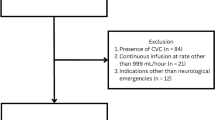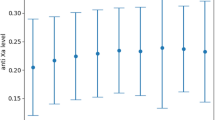Abstract
Objective
Shunt malfunctions seem more frequent in children (44 to 81%) than in adults (18 to 29%). Because of discrepancies between studies, it is not possible to affirm this disparity. The objective was to verify whether the incidence of cerebrospinal fluid (CSF) shunt malfunctions is higher in children than adults.
Methods
We present a retrospective series of child and adult patients who underwent CSF shunt placement between 2000 and 2013 with a Sophysa SM8® valve.
Results
599 adults and 98 children (sex ratio 1.28) underwent CSF shunt placement. Age at first surgery ranged between 1 day of life and 90 years (mean of 55.8 years, SD 25.8, median 64.8 years). The mean follow-up was 4 years (SD 4.264, 0–16; median 3 years). The cumulative complication rate was 25.5% (178/697). Mechanical complications were disconnection (25.1%), migration (11.8%), intracranial catheter obstruction (8.9%) and malposition (8.4%). The mean delay for the first revision was 1.90 years (0–13.9), (SD 2.73, median 0.5). The probability of shunt failure was 65% at 10 years in the child group and 36% at 10 years in the adult group. Moreover, in the child group, 33% of revisions occurred during the first year after shunt placement versus 17% in the adult group. Thus, the probability of shunt failure was higher in children than in adults (log-rank test, p < 0.001).
Conclusions
This is the first retrospective study, comparing children and adults undergoing CSF shunt using the same valve, able to confirm the higher rate of complications in children.




Similar content being viewed by others
References
Zemack G, Romner B (2000) Seven years of clinical experience with the programmable Codman Hakim valve: a retrospective study of 583 patients. J Neurosurg 92:941–948. https://doi.org/10.3171/jns.2000.92.6.0941
Borgbjerg BM, Gjerris F, Albeck MJ, Hauerberg J, Børgesen SE (1995) Frequency and causes of shunt revisions in different cerebrospinal fluid shunt types. Acta Neurochir 136:189–194
Drake JM, Kestle JR, Milner R et al (1998) Randomized trial of cerebrospinal fluid shunt valve design in pediatric hydrocephalus. Neurosurgery 43:294–303 discussion 303-305
Kehler U, Kiefer M, Eymann R, Wagner W, Tschan CA, Langer N, Rohde V, Ludwig HC, Gliemroth J, Meier U, Lemcke J, Thomale UW, Fritsch M, Krauss JK, Mirzayan MJ, Schuhmann M, Huthmann A (2015) PROSAIKA: a prospective multicenter registry with the first programmable gravitational device for hydrocephalus shunting. Clin Neurol Neurosurg 137:132–136. https://doi.org/10.1016/j.clineuro.2015.07.002
Kestle J, Drake J, Milner R, Sainte-Rose C, Cinalli G, Boop F, Piatt J, Haines S, Schiff S, Cochrane D, Steinbok P, MacNeil N (2000) Long-term follow-up data from the Shunt Design Trial. Pediatr Neurosurg 33:230–236. https://doi.org/10.1159/000055960
Kestle JRW, Walker ML, Investigators S (2005) A multicenter prospective cohort study of the Strata valve for the management of hydrocephalus in pediatric patients. J Neurosurg 102:141–145. https://doi.org/10.3171/jns.2005.102.2.0141
Khan F, Rehman A, Shamim MS, Bari ME (2015) Factors affecting ventriculoperitoneal shunt survival in adult patients. Surg Neurol Int 6:25. https://doi.org/10.4103/2152-7806.151388
Kulkarni AV, Riva-Cambrin J, Butler J, Browd SR, Drake JM, Holubkov R, Kestle JRW, Limbrick DD, Simon TD, Tamber MS, Wellons JC, Whitehead WE et al (2013) Outcomes of CSF shunting in children: comparison of Hydrocephalus Clinical Research Network cohort with historical controls: clinical article. J Neurosurg Pediatr 12:334–338. https://doi.org/10.3171/2013.7.PEDS12637
McGirt MJ, Leveque J-C, Wellons JC et al (2002) Cerebrospinal fluid shunt survival and etiology of failures: a seven-year institutional experience. Pediatr Neurosurg 36:248–255. https://doi.org/10.1159/000058428
Paulsen AH, Lundar T, Lindegaard K-F (2010) Twenty-year outcome in young adults with childhood hydrocephalus: assessment of surgical outcome, work participation, and health-related quality of life. J Neurosurg Pediatr 6:527–535. https://doi.org/10.3171/2010.9.PEDS09548
Reddy GK, Bollam P, Caldito G (2014) Long-term outcomes of ventriculoperitoneal shunt surgery in patients with hydrocephalus. World Neurosurg 81:404–410. https://doi.org/10.1016/j.wneu.2013.01.096
Reddy GK, Bollam P, Shi R, Guthikonda B, Nanda A (2011) Management of adult hydrocephalus with ventriculoperitoneal shunts: long-term single-institution experience. Neurosurgery 69:774–780; discussion 780-781. https://doi.org/10.1227/NEU.0b013e31821ffa9e
Shah SS, Hall M, Slonim AD, Hornig GW, Berry JG, Sharma V (2008) A multicenter study of factors influencing cerebrospinal fluid shunt survival in infants and children. Neurosurgery 62:1095–1102; discussion 1102-1103. https://doi.org/10.1227/01.neu.0000325871.60129.23
Shannon CN, Acakpo-Satchivi L, Kirby RS, Franklin FA, Wellons JC (2012) Ventriculoperitoneal shunt failure: an institutional review of 2-year survival rates. Childs Nerv Syst 28:2093–2099. https://doi.org/10.1007/s00381-012-1830-9
Shannon CN, Carr KR, Tomycz L, Wellons JC, Tulipan N (2013) Time to First Shunt Failure in Pediatric Patients over 1 Year Old: A 10-Year Retrospective Study. Pediatr Neurosurg 49:353–359. https://doi.org/10.1159/000369031
Stone JJ, Walker CT, Jacobson M, Phillips V, Silberstein HJ (2013) Revision rate of pediatric ventriculoperitoneal shunts after 15 years. J Neurosurg Pediatr 11:15–19. https://doi.org/10.3171/2012.9.PEDS1298
Sainte-Rose C, Piatt JH, Renier D, Pierre-Kahn A, Hirsch JF, Hoffman HJ, Humphreys RP, Hendrick EB (1991) Mechanical complications in shunts. Pediatr Neurosurg 17:2–9. https://doi.org/10.1159/000120557
Tuli S, Drake J, Lawless J, Wigg M, Lamberti-Pasculli M (2000) Risk factors for repeated cerebrospinal shunt failures in pediatric patients with hydrocephalus. J Neurosurg 92:31–38. https://doi.org/10.3171/jns.2000.92.1.0031
Liptak GS, McDonald JV (1985) Ventriculoperitoneal shunts in children: factors affecting shunt survival. Pediatr Neurosci 12:289–293
Piatt JH, Carlson CV (1993) A search for determinants of cerebrospinal fluid shunt survival: retrospective analysis of a 14-year institutional experience. Pediatr Neurosurg 19:233–241; discussion 242. https://doi.org/10.1159/000120738
Dave P, Venable GT, Jones TL, Khan NR, Albert GW, Chern JJ, Wheelus JL, Governale LS, Huntoon KM, Maher CO, Bruzek AK, Mangano FT, Mehta V, Beaudoin W, Naftel RP, Basem J, Whitney A, Shimony N, Rodriguez LF, Vaughn BN, Klimo P Jr (2019) The Preventable Shunt Revision Rate: A Multicenter Evaluation. Neurosurgery 84:788–798. https://doi.org/10.1093/neuros/nyy263
Wu Y, Green NL, Wrensch MR, Zhao S, Gupta N (2007) Ventriculoperitoneal shunt complications in California: 1990 to 2000. Neurosurgery 61:557–562; discussion 562-563. https://doi.org/10.1227/01.NEU.0000290903.07943.AF
Venable GT, Dave P, Gordon WE, Fraser BD, Wallace DA, Mangham W, Taylor DR, Khan NR, Michael LM II, Vaughn BN, Klimo P Jr (2020) Application of the Preventable Shunt Revision Rate to an Adult Population. World Neurosurg 134:e815–e821. https://doi.org/10.1016/j.wneu.2019.11.018
Reddy GK, Bollam P, Caldito G (2012) Ventriculoperitoneal shunt surgery and the risk of shunt infection in patients with hydrocephalus: long-term single institution experience. World Neurosurg 78:155–163. https://doi.org/10.1016/j.wneu.2011.10.034
Beuriat P-A, Puget S, Cinalli G, Blauwblomme T, Beccaria K, Zerah M, Sainte-Rose C (2017) Hydrocephalus treatment in children: long-term outcome in 975 consecutive patients. J Neurosurg Pediatr 20:10–18. https://doi.org/10.3171/2017.2.PEDS16491
Author information
Authors and Affiliations
Corresponding author
Ethics declarations
Ethics approval
This paper reports a retrospective study, formal consent is not required for this type of study. Moreover, this retrospective study was approved by our institutional review board and did not raise ethical issues and fell outside the scope of the rules governing biomedical research (articles L.1121-1-1 and R1121-3 of the Code of Public Health).
Conflict of interest
All authors certify that they have no affiliations with or involvement in any organization or entity with any financial interest (such as honoraria; educational grants; participation in speakers’ bureaus; membership, employment, consultancies, stock ownership, or other equity interest; and expert testimony or patent-licensing arrangements), or non-financial interest (such as personal or professional relationships, affiliations, knowledge, or beliefs) in the subject matter or materials discussed in this manuscript.
Additional information
Publisher’s note
Springer Nature remains neutral with regard to jurisdictional claims in published maps and institutional affiliations.
Supplementary Information
Supplementary Figure 5.
Population pyramid with demographic characteristics of the patients. The 697 patients were split according to age and sex (JPG 151 kb).
Supplementary Figure 6:
Actuarial probability of shunt survival time according to Kaplan Meier method in the overall population. The risk of failure is maximal during the first year (88%) and lowers to 44% at 10 years. (JPG 98 kb).
Supplementary Figure 7
Violin plot comparing the probability density of the age at surgery for pediatrics and adults, smoothed by a kernel density estimator. The mean is represented by a black diamond. The distribution of the population is represented by points. (JPG 132 kb).
Rights and permissions
About this article
Cite this article
Coll, G., Abed Rabbo, F., de Schlichting, E. et al. Mechanical complications of cerebrospinal fluid shunt. Differences between adult and pediatric populations: myths or reality?. Childs Nerv Syst 37, 2215–2221 (2021). https://doi.org/10.1007/s00381-021-05125-8
Received:
Accepted:
Published:
Issue Date:
DOI: https://doi.org/10.1007/s00381-021-05125-8




